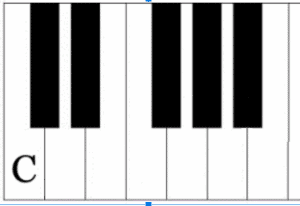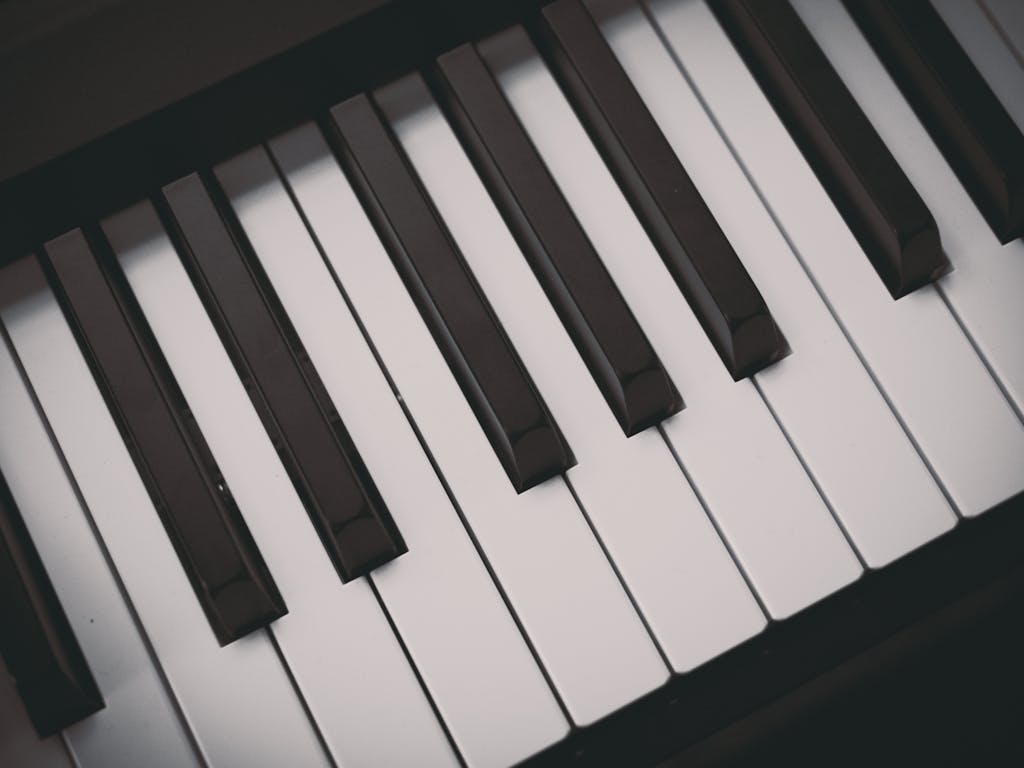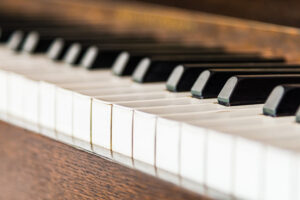The piano is one of the most versatile instruments you can learn. Learning piano keys can feel overwhelming at first. However, knowing your way around a keyboard is a vital skill for any musician and will unlock a whole new world of music and chords for you. In this article we will cover what piano keys are, how many keys a piano has, what the difference between the white and black keys is and how all these keys are laid out. Here at Skoove, we are dedicated to helping you reach your piano goals. Whether you’re starting out on your piano journey or just curious, this expert guide will help you decode the keyboard and set you up for musical success.

What are piano keys?
Piano keys are the black and white keys on the keyboard. Each key represents a specific musical note. At first glance, the layout might seem overwhelming, however it’s actually based on a simple repeating pattern. This pattern is the key to understanding how melodies, chords, and scales are formed. As you progress, you’ll also encounter key signatures, which tell you which keys on the piano should be played as sharps or flats in a piece of music. These are tied directly to the layout of the piano keys and help shape the mood and character of the music you play.
What are the white keys on a piano?
You might be wondering, how many keys on a piano? It varies, A standard piano has 88 keys. These keys span seven full octaves plus a few extra notes, giving the piano its remarkable range. Some keyboards may have fewer or more keys with common smaller variants having 44 to 72 keys and some rare larger examples spanning 108 keys. All you need to start out is a keyboard size that works for you.
A standard piano has 52 white keys. These represent the natural notes of the musical alphabet: A, B, C, D, E, F and G. These white keys repeat in a consistent pattern across the keyboard corresponding to the notes in the C major scale, which has no sharps or flats. These white keys form the backbone of the piano, representing the natural notes and creating a familiar visual pattern that’s easy to follow. These keys are where most beginners start.
What are the black keys on a piano?
There are 36 black keys on a standard piano. These are grouped in sets of twos and threes. The black keys are the sharps and flats that enable music to have more character and complexity. Their arrangement in groups of twos and threes helps with orientation on the piano.
With black keys their name depends on the context they are used in.
The black keys can be called sharps (#) or flats (b), depending on their musical context. For example, the black key between C and D can be called either C# or Db.
Complete piano keyboard diagram
A piano keys chart is an invaluable tool for beginners, as it helps visualise the layout of the keyboard and understand the relationship between individual piano key notes.
Each key is labelled with its corresponding note name, making it much easier to grasp the basics of playing piano scales, chords and melodies. Keep this image to hand as a reference guide. You’ll notice a repeating pattern of note names across the keyboard, which occurs at both higher and lower pitches. These repetitions are referred to as different octaves, with each octave representing the same set of notes but at a higher or lower pitch. Recognising this pattern is key to understanding how these 12 pitches span the full range of the piano. Take a look at this diagram of labelled piano keys to help you visualise this layout.

How to identify all keys on a piano?
Now we have looked at a smaller range of keys, let’s look at a few tricks to remembering all the piano notes. The first trick is to learn the patterns of the black and white piano keys. If you look at the keyboard, you will notice on this diagram of a piano keyboard layout,there is a repeating pattern of 2 and 3 black keys.

C is often used by pianists as a reference note. C is on the outside-left of the group of 2 black keys:
Follow the musical alphabet up the keys until you reach C again, one octave higher. Now you know the names of all the white keys on piano.
Another helpful trick is to label the note names on your keyboard and knowing how to label piano keys is vital for this. You can accomplish this with easy to remove tape. This is a great trick for beginners to get to know the keyboard layout quickly and efficiently. Once you have your piano keys labelled, you can get rocking on some great tunes. Check out the Skoove app, it’s the perfect place to learn your next piano song.
What are the different types of piano keys?
Keys come in various styles and weights, including weighted, semi-weighted and unweighted. The weight significantly affects the feel of the keys. Understanding these differences is essential when choosing between a digital piano vs keyboard.
Acoustic pianos
- Acoustic pianos use a hammer-action system, where pressing a key triggers a felt-tipped hammer to strike a string. This mechanism creates a distinctive feel known as “action”.
- Pianos with lighter action are easier to play, while heavier action offers more resistance. All acoustic pianos operate on this principle.
Digital pianos
- Digital pianos vary in weight and action. Some use weighted keys to mimic the feel of acoustic pianos. These models are often more affordable and space-efficient than acoustic pianos.
- Others feature semi-weighted keys, where springs control the action. These keys are lighter and easier to play, making them ideal for beginners but less realistic in feel.
Electric pianos
- Many electric pianos have unweighted keys, also called “waterfall” or “synth” keys. These keys require minimal effort to press, making them perfect for young children or players who prioritize speed and versatility.
Mastering the piano keys is the first step to becoming a confident player. Take care to memorize the structure and placement of all the notes and keys and use our handy charts if you need them. Platforms like Skoove make this process interactive and fun, offering guided lessons and practice exercises to help you read and play music to your full potential.
Author of this blog post:
Matthew Dickman

With over a decade of experience in music education Matthew holds a BA in Music from Paul McCartney’s LIPA and an MA in Composition from the University of Salford. Mathew has developed a distinctive compositional voice and approach to music theory education through his research and work in the music industry. Matthew’s writing for Skoove combines experience from orchestral and media composition, and as a gigging jazz musician, to create a wholistic and accessible pedagogy for musicians of any level. Away from music, he enjoys reading and exploring nature to expand his horizons and knowledge contributing to his holistic teaching style.














